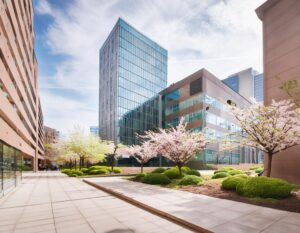- High Vacancy Rates and Tech Sector Impact: Denver has one of the highest office market vacancy rates in the U.S. at 15.7%, exceeding Great Recession levels. The significant presence of tech companies has made the market more vulnerable to downsizing as these firms seek cost-cutting measures amidst labor shortages.
- Increased Office Availabilities and Sublet Competition: Office availabilities in Denver have hit an all-time high, providing tenants with numerous options. The market is now experiencing heightened competition from sublet listings and new developments. Companies attempting to offload space are reducing prices, with the difference between direct and sublet asking rents widening to over $9 per square foot, compared to less than $2 per square foot in early 2020.
- Cherry Creek Submarket Performance: Despite the overall market challenges, Cherry Creek stands out with positive net absorption and rents exceeding the metro average. This submarket benefits from a high concentration of 4—and 5-star properties, attracting tenants through flight-to-quality trends.
- Professional Services Sector and Flight to Quality: Professional services firms, particularly law firms, are moving to premium office spaces in downtown Denver to enhance recruitment and retention. Developers are building new, amenity-rich buildings to meet this demand, with 4.1 million square feet under construction—the highest level since 2017.
- Decline in Investment Activity: Recent quarters have seen a decline in investment activity due to ongoing market uncertainty. Vacant value-add assets, previously attractive to investors for their lower prices, have lost appeal as available space increases and banks impose stricter lending standards.
Page Contents
- High Vacancy Rates and Tech Sector Impact
- Increased Office Availabilities and Sublet Competition
- Cherry Creek Submarket Performance
- Professional Services Sector and Flight to Quality
- Leasing Activity and Long-term Deficit
- Annual Absorption and Asset Quality Bifurcation
- Surge in Available Sublease Space
- Downsizing and Long-term Growth Challenges
- High Vacancy Rates and Tech Sector Impact
- Increased Office Availabilities and Sublet Competition
- Cherry Creek Submarket Performance
- Professional Services Sector and Flight to Quality
- Decline in Investment Activity
- Leasing Activity and Long-term Deficit
- Annual Absorption and Asset Quality Bifurcation
- Surge in Available Sublease Space
- Downsizing and Long-term Growth Challenges
- Stalled Rent Growth and Market Adjustments
- Cherry Creek’s Continued Strength
- Slow Recovery and Competitive Pricing
- Platte River’s Emergence as a Desirable Office Hub
- Innovative T3 RiNo Project
- The Current: Leveraging Mass Transit
- 1900 Lawrence: A New High Rise in CBD
- Block 162: Premium Features for Modern Tenants
- Investment Activity Declines Amid Uncertainty
- Decline in Value-Add Assets’ Popularity
- Robust Pricing for Well-Leased Trophy Assets
- Cherry Creek’s Strong Investment Activity
- Connecting the Trends
- Closing Thoughts
High Vacancy Rates and Tech Sector Impact
Denver’s office vacancy rate is 15.7%, surpassing the previous high of 15.5% in 2003. The market’s large tech presence is a significant factor. Tech companies are downsizing to cut costs without reducing staff.
Increased Office Availabilities and Sublet Competition
Office availability has reached an all-time high. Due to the market’s condition, tenants now have numerous options. The difference between direct and sublet asking rents is over $9 per square foot. Companies are cutting prices to attract tenants.
Cherry Creek Submarket Performance
 Cherry Creek shows positive net absorption despite market challenges. Rents in this submarket outperform the metro average. It attracts tenants through flight-to-quality trends due to its high concentration of 4- and 5-star properties.
Cherry Creek shows positive net absorption despite market challenges. Rents in this submarket outperform the metro average. It attracts tenants through flight-to-quality trends due to its high concentration of 4- and 5-star properties.
Professional Services Sector and Flight to Quality
Law firms and other professional services are moving to premium spaces, which aids in recruitment and retention. Developers are building new, amenity-rich buildings to meet this demand. 4.1 million square feet are currently under construction.
Decline in Investment Activity
Investment activity has declined amid market uncertainty. Vacant value-add assets are less attractive to investors. Available space continues to increase, and banks are tightening lending standards, dampening investor interest in the market.
Leasing Activity and Long-term Deficit
Leasing activity has progressed since the pandemic’s depths. Over 2.3 million SF has been leased in six of the last eight quarters. Urban submarkets like CBD, Platte River, and LoDo have been active. However, leasing still lags behind pre-pandemic levels.
Annual Absorption and Asset Quality Bifurcation
Leasing improvements have yet to outpace move-outs. Annual absorption has been negative for three years. Older buildings record high negative net absorption and vacancies, while newer buildings have recently seen positive net absorption.
Surge in Available Sublease Space
The available sublease space is now 6.4 million SF, almost triple the amount during the Great Recession. The high concentration of tech companies drives this increase. They are cutting costs due to a high-interest rate environment.
Downsizing and Long-term Growth Challenges
Tenants are reducing their office footprints. Companies use more efficient floor plans, needing less space. The average lease size is down 45% from its 2015 peak. Major leases, like Davis Graham & Stubbs’, illustrate this downsizing trend.
High Vacancy Rates and Tech Sector Impact
Denver’s office vacancy rate is 15.7%. This rate surpassed the previous high of 15.5% in 2003. The significant presence of tech companies contributes to this high rate. These companies are downsizing to cut costs without reducing staff.
Increased Office Availabilities and Sublet Competition
Office availabilities have reached an all-time high. Tenants now have numerous options in the market. The difference between direct and sublet asking rents is over $9 per square foot. Companies are reducing prices to attract prospective tenants.
Cherry Creek Submarket Performance
Cherry Creek shows positive net absorption despite overall market challenges. Rents in this submarket outperform the metro average. Cherry Creek attracts tenants through flight-to-quality trends due to its high concentration of 4—and 5-star properties.
Professional Services Sector and Flight to Quality
Professional services firms are moving to premium office spaces, which aids recruitment and retention efforts. Developers are building new, amenity-rich buildings to meet this  demand. Currently, 4.1 million square feet are under construction.
demand. Currently, 4.1 million square feet are under construction.
Decline in Investment Activity
Investment activity has declined due to market uncertainty. Vacant value-add assets are less attractive to investors. Available space is increasing, and banks are tightening lending standards, dampening investor interest in the market.
Leasing Activity and Long-term Deficit
Leasing activity has improved since the pandemic’s depths. Over 2.3 million SF has been leased in six of the last eight quarters. Urban submarkets like CBD, Platte River, and LoDo have been particularly active. However, leasing still lags behind pre-pandemic levels.
Annual Absorption and Asset Quality Bifurcation
Leasing improvements have yet to outpace move-outs. Annual absorption has been negative for three years. Older buildings record high negative net absorption and increasing vacancies, while newer buildings have seen positive net absorption recently.
Surge in Available Sublease Space
The available sublease space is now 6.4 million SF, almost triple the amount during the Great Recession. The high concentration of tech companies drives this increase. They are cutting costs due to a high-interest rate environment.
Downsizing and Long-term Growth Challenges
Tenants are reducing their office footprints, and companies are using more efficient floor plans, requiring less space. The average lease size is down 45% from its 2015 peak. Major leases, like Davis Graham & Stubbs’, illustrate this trend.
Stalled Rent Growth and Market Adjustments
Rent growth has stalled as tenants reassess their portfolios. Annual rent growth is at 1.2%, but inflation-adjusted growth is negative. Landlords face competition from new developments and sublet listings. Instead of lowering base rates, concessions in tenant improvements and free rent are offered.
Cherry Creek’s Continued Strength
Cherry Creek remains a bright spot for office demand. Rents here outperform the metro average. The area benefits from a concentration of high-quality assets. This submarket continues to capitalize on flight-to-quality trends.
Slow Recovery and Competitive Pricing
The market will likely recover slowly. Absorbing the available inventory will take time amid tempered demand. However, Denver’s office space offers a competitive price of $29.00 per square foot, a discount relative to coastal markets.
Platte River’s Emergence as a Desirable Office Hub
Platte River has become one of Denver’s most desirable areas for office tenants. Development has accelerated significantly in recent years, and the submarket is set to expand its inventory by over 15%. New developments focus on the fast-growing RiNo neighborhood near the 38th and Blake light rail station.
Innovative T3 RiNo Project
T3 RiNo, developed by Hines, McCaffery, and Ivanhoé Cambridge, broke ground in November 2021. This 250,000-SF mixed-use office project features the innovative T3 design. T3 (Timber, Transit, and Technology) utilizes heavy timber and floor-to-ceiling glass, paying homage to Denver’s historic brick buildings. The building is at 3500 Blake Street, near the 38th & Blake Rail Station.
The Current: Leveraging Mass Transit
Another office building, The Current, recently broke ground near the 38th & Blake Rail Station. Developed by Schnitzer West, the 280,000 SF office space capitalizes on Denver’s expanding light rail network. The A-Line commuter rail, opened in 2016, boosts RiNo’s viability. It connects riders to Union Station and Denver International Airport.
1900 Lawrence: A New High Rise in CBD
In the CBD, Riverside Investment & Development Company and Convexity Properties are developing 1900 Lawrence. This 32-story high-rise began construction in 2022 after pandemic-related delays. The project incorporates health and safety standards, including improved elevators, HVAC systems, and increased automation.
Block 162: Premium Features for Modern Tenants
Block 162 delivered 608,000 SF in Q2 2021 in a challenging leasing environment. It offers high-end features that appeal to post-COVID tenants, like top-tier HVAC and elevator systems. Denver-based law firm Sherman & Howard leased 60,000 SF, attracted by premium amenities and access to public transportation. The firm will relocate from 633 17th St.
Investment Activity Declines Amid Uncertainty
Investment activity slowed in the second half of 2022 due to uncertainty about office demand. Leasing has improved, but available space is at record levels. Companies are reassessing office utilization, impacting investment volumes and asset values. Inflationary pressures and recession fears suggest modest sales activity in the near term.
Decline in Value-Add Assets’ Popularity
Vacant, value-add assets have fallen out of favor as available space climbs. Banks are tightening lending standards. Investors now prefer cash-flowing properties. Properties traded since early 2022 averaged a 92% occupancy rate, showing demand for stable assets.
Robust Pricing for Well-Leased Trophy Assets
Prime, well-leased trophy assets continue to attract strong pricing. The Polsinelli law firm building at 1401 Lawrence sold for a record $752/SF in July. PGIM Real Estate bought the fully leased, 310,000-SF building for $233 million. This sale highlights investor preference for prime, income-generating properties.
Cherry Creek’s Strong Investment Activity
Cherry Creek remains a hotspot for investment with luxury office, apartment, and retail developments. The average pricing here is $400/SF, compared to the metro average of $240/SF. Recent record sales include 240 Saint Paul at $920/SF and Civica Cherry Creek at $921/SF. These sales reflect the submarket’s robust investment appeal.
Connecting the Trends
Despite a slow overall investment activity, prime assets in desirable locations like Cherry Creek and well-leased properties continue attracting investors. The shift from value-add assets to cash-flowing properties indicates a cautious but strategic approach. Investors are prioritizing stability and prime locations amid market uncertainties.
Closing Thoughts
Denver’s office market faces challenges, yet opportunities persist in prime locations. Investors are shifting to stable, cash-flowing assets. Cherry Creek remains a bright spot for investments. Contact Lumicre for your investment needs.